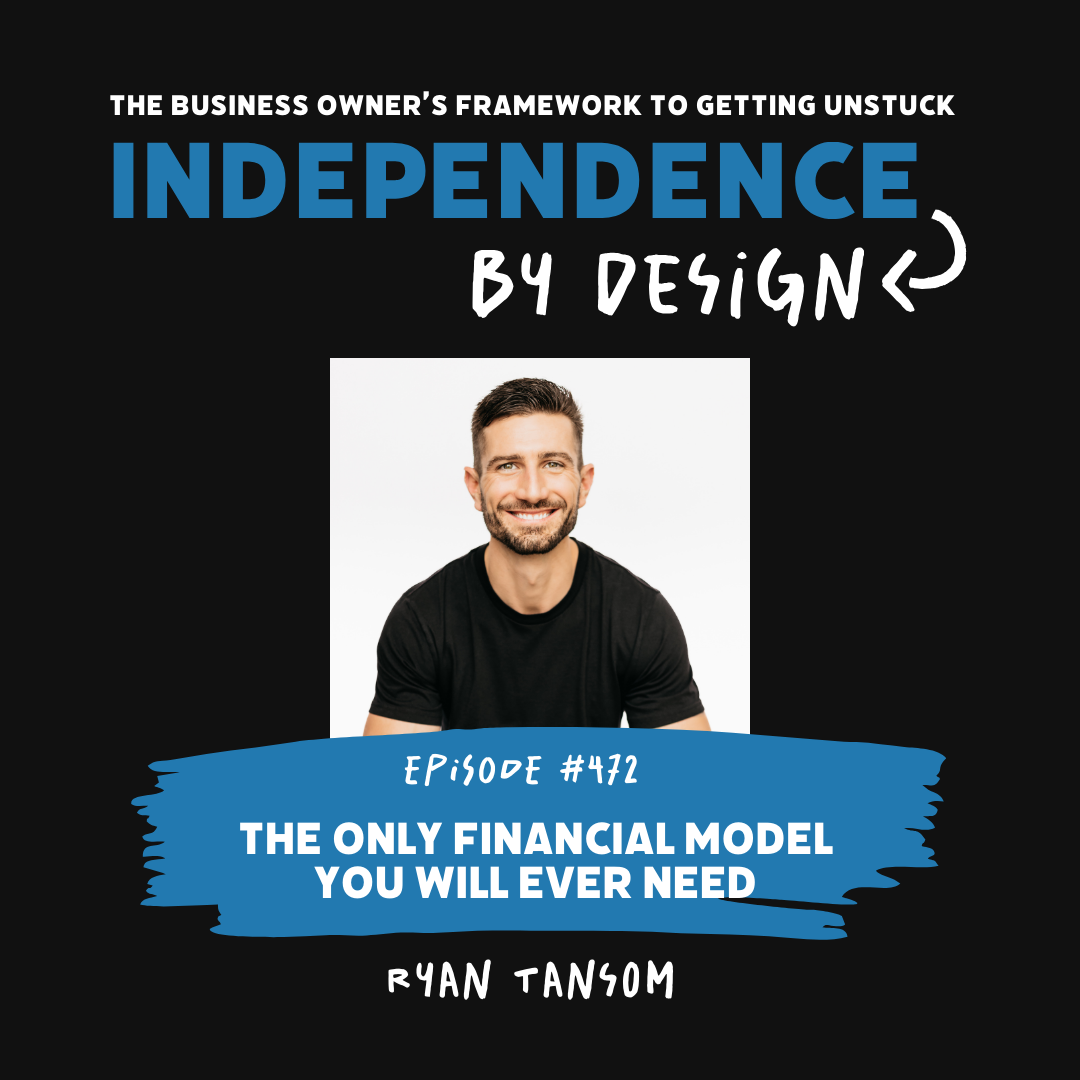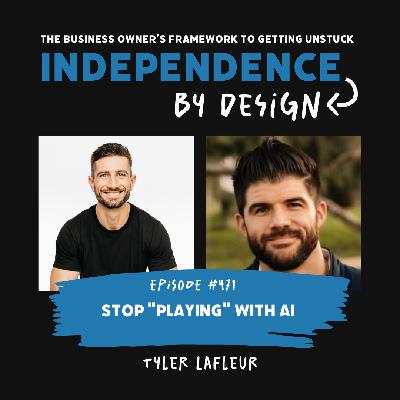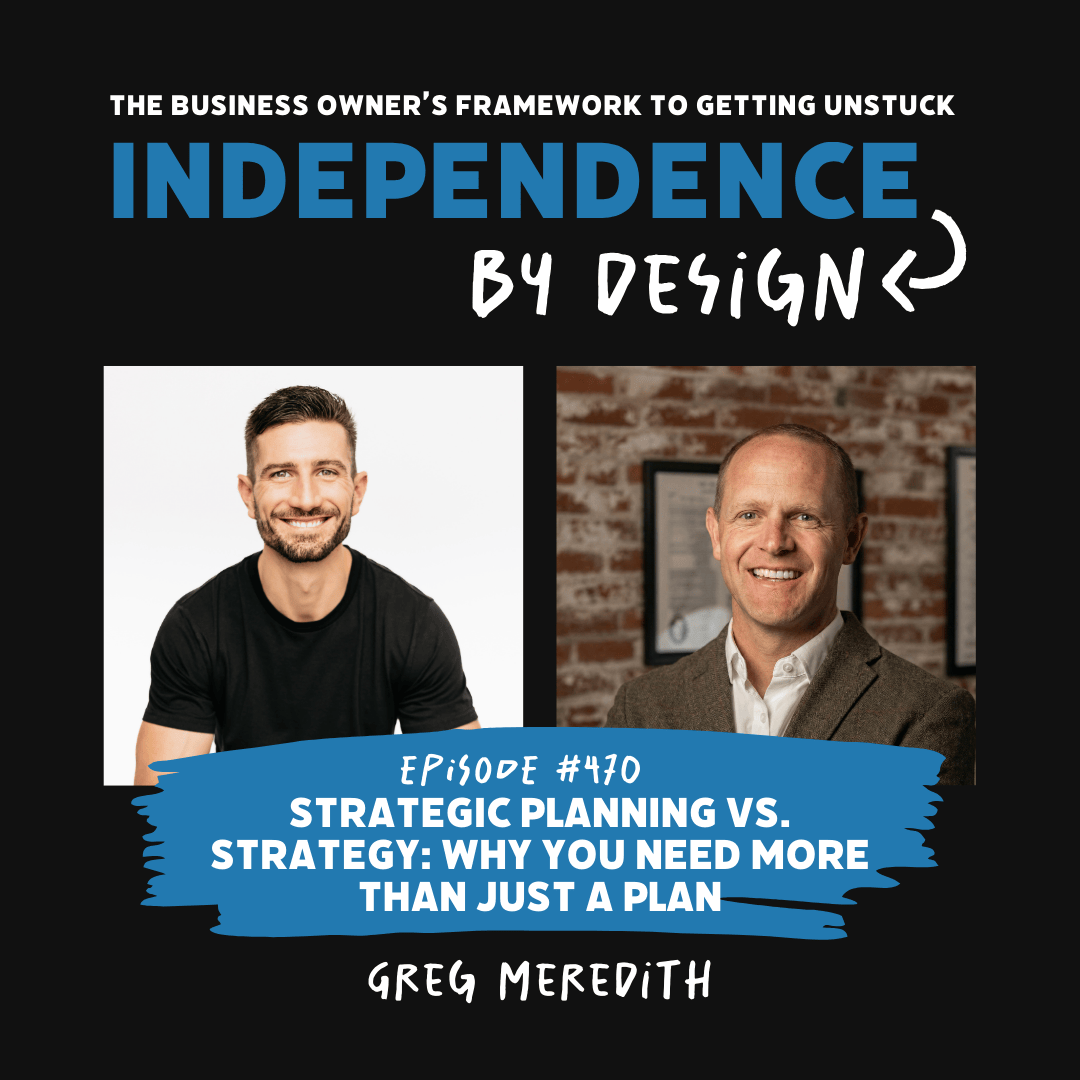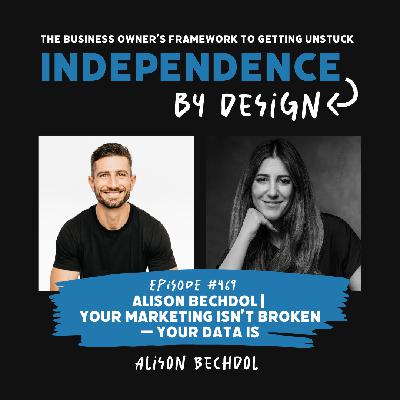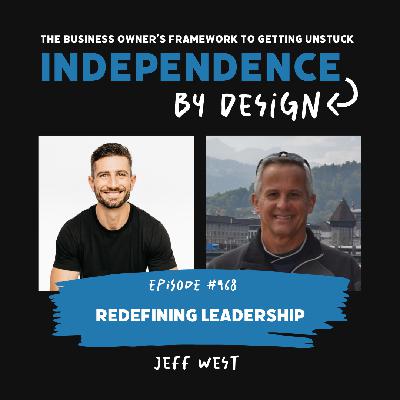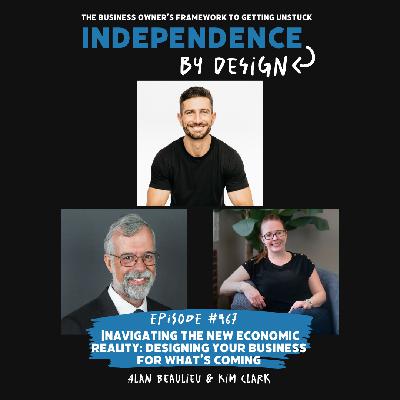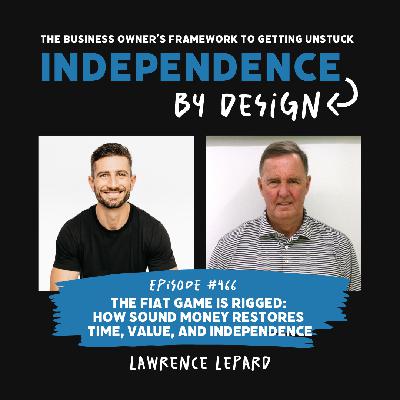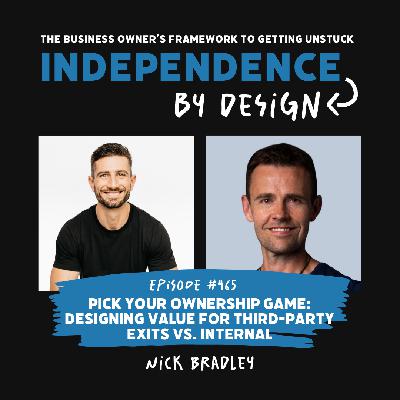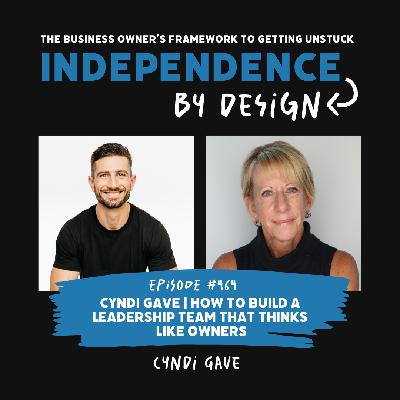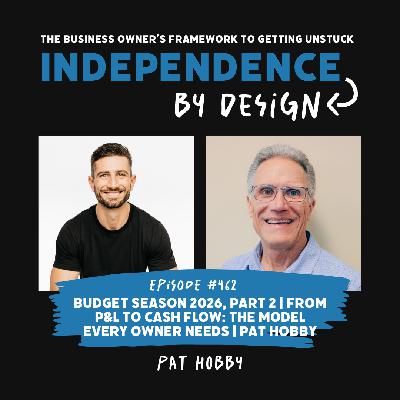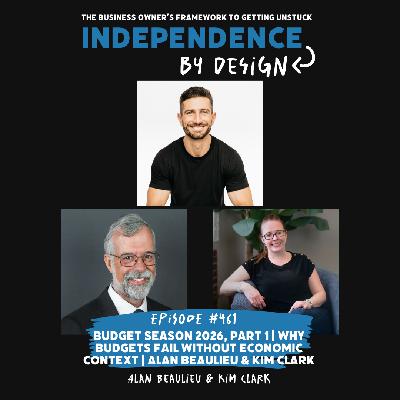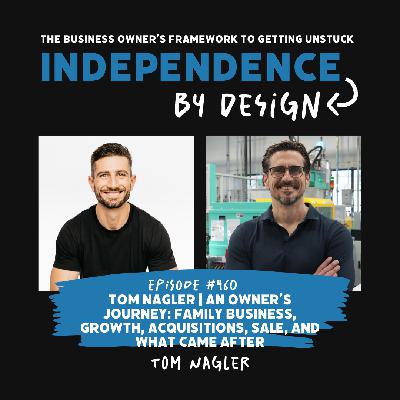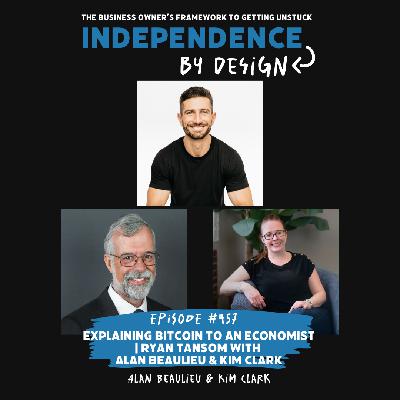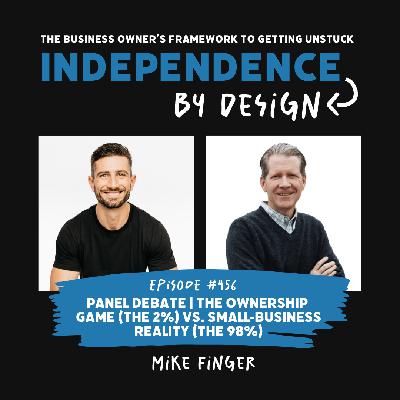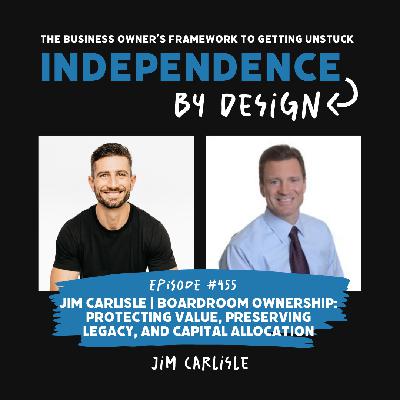Discover Independence by Design™
Independence by Design™

Independence by Design™
Author: Ryan Tansom
Subscribed: 3Played: 10Subscribe
Share
© 2024
Description
Independence by Design™ is a framework to help owner-operators get out of the weeds and lead from the boardroom.
I built it because I lived this trap. In 2009, I joined my dad in our $21M family business. We turned it around and sold it for eight figures in 2014 — enough to pay off debt, cover taxes, let my dad retire, and leave me with a chunk of cash at 27.
But the sale gutted our team, systems, and identity. It looked like a win, but it didn’t feel like freedom. I bawled in the driveway.
After 450+ interviews, thousands of owners, and multiple ventures, I saw the real issue: we didn’t know the difference between being owners and operators. Our goals weren’t aligned. And we had no framework to guide us.
That’s why I built iBD — to help owners avoid regret, reclaim their time, grow real equity value, and build a business that gives them freedom — whether they stay, scale, or sell.
This show is the one I wish I had.
I built it because I lived this trap. In 2009, I joined my dad in our $21M family business. We turned it around and sold it for eight figures in 2014 — enough to pay off debt, cover taxes, let my dad retire, and leave me with a chunk of cash at 27.
But the sale gutted our team, systems, and identity. It looked like a win, but it didn’t feel like freedom. I bawled in the driveway.
After 450+ interviews, thousands of owners, and multiple ventures, I saw the real issue: we didn’t know the difference between being owners and operators. Our goals weren’t aligned. And we had no framework to guide us.
That’s why I built iBD — to help owners avoid regret, reclaim their time, grow real equity value, and build a business that gives them freedom — whether they stay, scale, or sell.
This show is the one I wish I had.
75 Episodes
Reverse
Most owners don’t wake up wanting to sell their business. They wake up tired, overloaded, and unsure how much longer they can keep doing everything themselves. In this conversation, John Bartlett and I start by unpacking that reality — the moment when success on paper doesn’t feel like freedom, and selling starts to feel like the only option.
From there, we zoom out and talk about what’s really going on beneath the surface: phantom wealth, misunderstood cash flow, and why many owners don’t actually see the full set of options available to them. We talk about how value is created, what actually drives multiples, and why clarity around cash flow and owner dependency changes everything.
Only after that foundation is set do we walk through the real process of selling a company — what actually happens when you go to market, how deals are structured, how long it takes, where owners get surprised, and why the headline price is often the least important part of the transaction. This episode is about helping you see the whole landscape clearly — so whether you build, transition, or sell, you’re making an intentional decision instead of reacting out of exhaustion. John Bartlett is the founder of Brentwood Growth, where he helps owner-operators navigate valuation, growth, and M&A decisions with clarity and realism. A former serial entrepreneur, John grew and sold multiple businesses before becoming an advisor to lower middle-market owners. His work focuses on turning companies into durable assets—whether that means scaling, de-risking, or exiting on aligned terms.
Top 10 Takeaways
Most owners don’t want to sell their business — they want relief from carrying everything themselves.
Phantom wealth is common: businesses look valuable on paper but don’t produce real freedom or liquidity.
Enterprise value is driven by adjusted EBITDA and the confidence buyers have in future cash flow.
Owner dependency is one of the biggest value killers, even in otherwise strong businesses.
Selling is not a moment — it’s a long, demanding process that reshapes the owner’s life for months or years.
Deal structure (taxes, earn-outs, rollover equity, timing) often matters more than the headline price.
Most owners dramatically underestimate how long a real M&A process takes and how consuming it is.
Buyers pay for predictability, not potential, and confidence in cash flow determines the multiple.
Owners who wait until burnout have fewer options and less leverage than they realize.
The best outcomes happen when owners understand their options early and choose intentionally, not reactively.
Chapters:
(00:00) Making a meaningful difference in business owners' lives and transitions
(06:08) Three categories of sellers: burned out, transitioning, and scaling
(10:40) Life as jigsaw puzzle: balancing financial and lifestyle goals
(25:45) What owners really want is work-life balance and control
(36:10) Valuation process: determining current worth and future potential value
(46:10) Valuation fundamentals: adjusted EBITDA and multiple determine enterprise value
(01:01:40) Complete M&A process timeline from teaser to final offers
(01:10:10) Marathon hydration analogy: plan your exit before you're exhausted
(01:14:00) Quality of earnings: the detailed due diligence cavity search
(01:26:20) Critical difference between gross sale proceeds and after-tax reality
(01:28:33) Lock business down within twelve months of planned sale
Resources: John Bartlett LinkedIn: https://www.linkedin.com/in/johnl...
Chapters
(00:00:00) - Independence by Design: Selling Your Company(00:01:55) - Why Business Owners Should Sell Their Companies(00:05:59) - Owners in Their 60s, 70s Should They Sell the(00:12:41) - Ownership: The 7 Levels of Growth(00:20:24) - Jack Stack on Ownership at 82(00:22:26) - Ownership vs Operator: The Problem(00:24:48) - Owner Operator Bifurcation(00:32:05) - Steve Ballentine on the Value of the Business(00:35:35) - Exploring the Value of the Business(00:43:30) - How to Win with a Size Client(00:43:49) - Private Equity Brokers: Enterprise Value of Companies(00:45:05) - Exploring the Multiple of a Private Business(00:50:43) - Adjusted EBITDA Multiple(00:57:55) - How To Find a Buyer for Your Startup(01:02:32) - Have You Validated Any Offer?(01:05:26) - Part 6: Hydration(01:11:09) - The Offer for the Business(01:15:01) - Do Over 80% of Deals Get Sold?(01:17:55) - Does an Earnout Make a Bonus?(01:27:02) - Should You Do a Significant Deal?
Most owners make decisions in the dark. Sales over here, payroll over there, cash flow somewhere in the background — and no clear way to see how it all fits together.Watch on YouTube
In this episode, I break down the 5-year, three-statement model I use with clients to finally show how revenue, margins, OpEx, working capital, cash flow, and valuation all connect. It's the system that turns guessing into clarity, scattered decisions into strategy, and helps you design a business that aligns with your goals for time, cash flow, and long-term wealth.
When owners finally see the whole picture — how their decisions drive EBITDA, how working capital eats cash, how valuation is created, and how comp and accountability align to their goals — they gain the ability to run the company from the boardroom instead of the weeds.I know what it's like to feel trapped in the grind of running a business. In 2009, I joined my family's $21 million company during a financial crisis, and over five years, we turned it around and sold it for eight figures. While that sale looked like a win on paper, it left me questioning everything. The stress of running the business, the massive tax hit, and the lack of clarity about how our decisions aligned with our goals taught me a powerful lesson: most business owners don't have a framework to make decisions that lead to true freedom.That's why I created the Independence by Design™ Ownership Framework. It's a system to help owner-operators align their business decisions with their goals for time, cash flow, and wealth. Over the last decade, I've been a part of dozens of transactions and worked with thousands of business owners, helping them design businesses that work for their lives—not the other way around.
On the podcast, I share strategies and insights I've learned along the way, bringing in top thought leaders like Gino Wickman, Mike Michalowicz, Jack Stack, and Bo Burlingham to provide their perspectives. Whether you're feeling stuck, planning to scale, or preparing for an exit, my goal is to give you the tools and confidence to take back control and build a life you love.
This isn't just another business podcast. It's about reclaiming your independence and designing a business that gives you the freedom you deserve.Top 10 Takeaways
Your ownership goals must drive the business model — not the other way around.
A business is a system — and the three statements show the whole system at once.
Valuation is not a mystery — it’s predictable math tied to cash flow.
The "valuation gap" determines whether your dreams are mathematically possible.
Revenue must be predictable — and that requires a mapped customer journey and measurable funnel.
Margins are an operational scorecard — not just accounting output.
Working capital is the silent killer — and explains why the bank balance never matches the P&L.
The cash flow statement is the bridge between ownership and operations.
Comp plans must be tied to the model — aligning the team around revenue, margin, EBITDA, and cash.
The model is the owner’s decision engine — allowing them to elevate into the boardroom.
Chapters: (00:00) Why ownership goals must drive your business model: time, cash and wealth
(04:22) The valuation gap tab: understanding enterprise value and equity value
(09:30) Projections: building your five-year revenue and growth assumptions
(13:00) Revenue forecasting: line of busi...
Chapters
(00:00:00) - Independence by Design(00:01:51) - Why Your Own Money Is SO Important(00:09:37) - Out Year Projections(00:17:42) - Adjusted EPS and normalized EBITDA(00:19:09) - The Earnings Statement, Cash Flow Statement(00:26:38) - Distributions and Cash Flow(00:33:44) - The Sales and Marketing Journey(00:38:53) - The 3-Step Process for Operations(00:45:58) - The Business Valuation Model(00:49:20) - The Income Statement Comparison and Budget Comparison(00:51:39) - Exporting the Trial Balance from Cash Flow(00:57:40) - Grow Your Business With a Fear of the Future
You hear the hype about AI every day, but when you try to use it, it feels like a toy rather than a tool that can actually help you reclaim your time.
Watch on YouTubeIn this episode, I’m cutting through that noise with Tyler LaFleur, a former nurse and functional medicine practitioner turned Fractional COO. I brought Tyler on because he doesn’t look at business through the lens of "growth at all costs." He uses first principles thinking—the same diagnostic approach used in medicine—to find the root cause of what is keeping you stuck in the day-to-day.We have a candid, practical conversation about why most business owners fail with AI because of "lazy prompting," and why Artificial Intelligence is useless without "Objective Truth." If you don’t have your financial constraints and ownership goals clearly defined first, applying AI is just pouring rocket fuel into a car with no steering wheel—you’ll just hit the wall faster.Top 10 Takeaways
First Principles Thinking: Just like in functional medicine, you must strip a business down to its core mechanics to find the root cause, not just treat the operational symptoms.
The "More" Trap: When an owner lacks a definitive financial goal, the default strategy becomes a chaotic, exhausting pursuit of "more" revenue without more freedom.
AI Needs Constraints: AI is a rocket ship, but it needs a rudder. Without the "Objective Truth" of your financial model and ownership goals, AI will hallucinate a path to nowhere.
Visionary vs. Integrator: Visionaries are great at starting fires but terrible at putting them out. AI can act as the "Integrator" that documents processes and executes the details you hate.
Don't Automate a Mess: Before building complex agents, start with "low-hanging fruit"—the repetitive administrative tasks that steal 6-10 hours of your time every month.
Lazy Prompting: The reason AI "doesn't work" for most owners is that they treat it like Google. You must give it deep context (your strategy, constraints, and voice) to get boardroom-level output.
Claude vs. ChatGPT: For business owners, Tyler recommends Anthropic’s Claude because its "Projects" feature allows you to upload your entire operating system as context.
Cleaning Financial Data: You can teach AI a "Skill" (like cleaning a messy trial balance or categorizing expenses) by simply showing it a transcript of you doing it once.
The "Ladder on the Wrong Wall": AI will help you execute a bad strategy faster. Efficiency is useless if it’s driving you toward a business model you hate.
Just Start: You cannot break the AI. The biggest risk to your business isn't AI taking over; it's your competitor using it to move twice as fast while you wait for it to get "easier."
Tyler LaFleur is a Fractional COO and AI integration specialist who helps visionaries escape the weeds. A former nurse and functional medicine practitioner, Tyler bridges the gap between biological systems and business operations, using "first principles" to diagnose and cure operational bottlenecks. He specializes in practical AI application—moving beyond the hype to build custom agents, automate workflows, and clean financial data using tools like Claude and ChatGPT.
Chapters:
(00:00) Tyler's journey from nursing to fractional COO to AI integration
(06:23) First principles thinking applied to healt...
Chapters
(00:00:00) - Independence by Design: First Principles Thinking(00:02:59) - How to Lead an AI-Driven Company(00:06:01) - Nurses vs Business: What's The Connection?(00:08:11) - How Functional Medicine Became Outcome Driven(00:13:53) - Learning From the Pros(00:15:14) - Leadership Made Easy(00:20:32) - Dr. Thayer: I Interrupt My Guests(00:20:56) - The First Principles of Business in AI(00:28:09) - Steve Ballentine on Goals and the Process(00:32:41) - Board of Directors: The Cash Flow constraint(00:37:47) - The Objective Reality of Spending(00:42:21) - How to Manage Your Business's Financials(00:46:00) - Multiple Valuation For Small Businesses(00:47:49) - Steve Jobs on Strategic Planning, Sales and Marketing as Silos(00:53:59) - How To Manage a High Cost Business(00:54:23) - How To Build Your Business on the Wrong Wall(01:00:46) - Analytical Data Analysis with ChatGPT and Anthropic Squad(01:04:34) - Gemini 3.0 vs. OpenAI: The Best(01:06:57) - How to Use AI in Your Company's Business(01:11:09) - Building a social network with AI(01:17:42) - Beyond the Prompts: Chat(01:23:41) - How to Build a Business with AI?(01:27:47) - What's The Barrier to AI in Business?(01:33:11) - On Automation and the Future of Business(01:40:13) - Tyler the Creator on Less Needing His Business
In this episode, I sit down with Greg Meredith, founder of Simply Strategic, to distinguish the crucial difference between having a strategic plan and actually possessing a strategy. We dive deep into Greg’s "9 Keystones" Simply Strategic framework, exploring how companies can identify their unique "Winning Position" on the battlefield of business. Greg explains why true strategy requires painful trade-offs, the importance of the "Opposite Rule" in decision-making, and how to successfully integrate high-level strategy into a daily business operating system for long-term execution.Watch on YouTube
Top 10 Takeaways
Strategy vs. Planning: Planning is the process, but the goal is a specific "Winning Position" on the competitive landscape.
The Opposite Rule: If the opposite of your strategy looks ridiculous (e.g., "we give bad service"), you haven't made a real choice.
The Power of Trade-offs: You cannot say "yes" to what matters most without aggressively saying "no" to other opportunities.
Pick Your Hill: Companies usually win on one of five hills: Singular, Integrated, Preferred, Potent, or Scaled
True Company Assets: Real assets aren't just on the balance sheet; they are the rare or "unmatchable" capabilities competitors can't copy.
The Bullseye: Define success multi-dimensionally: set specific targets for culture, operations, and clients, not just revenue.
Embrace the "Messy Middle": High-trust teams must fight through tension and disagreement to reach true alignment.
3 Phases of Strategy: A complete cycle requires three distinct phases: Prepare, Plan, and Persist.
Progress Over Perfection: A 70% plan executed today is better than waiting indefinitely for a perfect strategy.
Strategy Needs a System: A strategic plan is useless without a business operating system (like EOS) to ensure execution.
Key Quotes
"We start with this core definition of strategy is using company assets to create a high-impact winning position." - Greg Meredith
"Can you define your strategy in such a way that a logical, savvy, even wise competitor would look at the opposite of your strategy and say, hey, that's viable, that's a good strategy." - Greg Meredith
"Strategy is about intentionally saying, we're gonna go there, we're gonna hold that ground, we're gonna win from that place."- Greg Meredith
"It's about trade-offs... You have to say no if you're really gonna say yes to the things that are most important."- Greg Meredith
"It's gravity, it's not earthquakes... We want to put in that consistent pull. Here's where we are, here's what we're working on, not we're going to have this one-time event that's going to shake everything up."- Greg Meredith
Greg Meredith
Greg Meredith is the founder of Simply Strategic, a consultancy dedicated to helping small and mid-sized businesses ($2M - $500M revenue) build and execute actionable strategic plans. With a background in private equity and over 75 strategic engagements, Greg guides leadership teams through his "9 Keystones" framework. He focuses on helping owners define their "winning position," leverage unique company assets, and transition from planning to persisting, ensuring strategy integrates seamlessly with daily operations.
Chapters
(00:00:00) - Independence by Design: Strategic Plan with Greg Meredith(00:01:08) - Back to Strategic Planning With Dan(00:01:59) - What Strategic Planning Is Really All About(00:03:51) - The 3-Step Process of Strategy(00:06:19) - What is a Strategic Plan and How to Win?(00:09:31) - Ownership Operating System vs Strategy(00:12:23) - Management: Say No to Everything(00:14:50) - The Opposite Rule in Strategy(00:19:06) - Mutual Funds and Expanding Their Business(00:24:55) - The Trust Factor in a Board Meeting(00:30:56) - President Trump on Handoff of the Ball(00:31:46) - The Winning Positions(00:34:17) - Quantum of Singularity: The Only Business with Access to Rare(00:40:29) - Importance of Scale in Building Products(00:42:03) - Three Winning Positions and None of the Others(00:44:09) - Executives: The Future of Connected Business(00:49:34) - Bradley: Strategic Planning, The 3 Phases(00:52:14) - The 3 Phases of Strategic Planning(00:55:18) - 9 Keystones of Strategic Planning(00:58:28) - Keystone 6(01:00:49) - What's The Most Valuable Idea in the Company?(01:05:42) - Importance of Core Beliefs in the Company(01:09:35) - The Process of Strategic Planning(01:13:02) - Company Assets and the Business Flywheel(01:19:00) - Steve Ballentine: The Bullseye(01:24:33) - Ownership Goals and the Operating System(01:31:19) - The Fitness Industry's 96%(01:31:54) - How to Build a Strategic Plan and Business Operating System
Marketing is confusing for most owners — not because the tactics don’t work, but because the data underneath is broken. Watch on YouTube In this episode, I sit down with Alison Bechdol, founder of Digital-ade, to break down why so many owners feel like they’re throwing money at marketing with nothing to show for it. And the truth is simple: you cannot build a predictable revenue engine without clean data, real attribution, and a clear picture of your customer acquisition cost. Most companies don’t have a marketing problem — they have a data infrastructure problem. Tracking is wrong, systems aren’t unified, and owners don’t have the visibility they need to design revenue, forecast cash flow, or make decisions from the boardroom. We also talk through the deeper issue: the marketing industry’s incentives are misaligned. Owners need doers, not gurus — and they need a clear order of operations to diagnose, fix, and scale what actually drives margin and enterprise value. 10 Takeaways:
Most owners don’t have a marketing problem — they have a data problem.
If attribution isn’t accurate, every marketing dollar becomes guesswork.
The marketing industry runs on misaligned incentives that reward activity over outcomes.
Many “strategic” roles lack operational depth, leaving owners paying for insight without execution.
Most companies’ tools are misconfigured, creating blind spots in revenue-critical data.
Bad data kills owner confidence and leads to reactive, inconsistent decisions.
There is a clear order of operations: fix tracking → unify systems → measure → optimize → then scale.
Predictable revenue comes from diagnostics and visibility, not tactics or trends.
Clean data + a reliable conversion funnel = predictable CAC, forecastable revenue, and controllable cash flow.
Clear data empowers owners to make boardroom-level decisions and allocate capital with confidence. Alison Bechdol is the owner of Digital-ade, specializing in analytics, tag management, event tracking, and paid media for both B2B and B2C companies. Known for cutting through noise and fixing the data foundations most businesses overlook, she helps owners build reliable tracking, clear attribution, and actionable insights. Alison also teaches GA4, KPIs, and Google Tag Manager through workshops, consulting, and speaking engagements.
Chapters:
(00:00) Alison's unconventional journey from event planning to analytics mastery
(05:45) First principles thinking and understanding consumer psychology in data
(12:37) Predictable revenue and mapping the complete customer journey
(15:37) Moving from mindset to implementation: where to start with data
(20:20) Setting goals and KPIs: working backwards from conversion points
(32:09) Building your dashboard: Looker Studio as single source of truth
(43:04) Why AI can't replace expertise: the insights problem explained
(56:00) Fractional resources and finding the right doers versus strategists
(1:12:37) Getting started today: implement tracking and identify conversion points
Rate, comment, and share with the owner/operators you know!
Resources: Company Website http://digital-ade.com/ Ryan Tansom Website https://ryantansom.com/
Chapters
(00:00:00) - Independence by Design: A Client Experience Dashboard(00:02:23) - Web Analytics: What's the Background for Everyone?(00:05:27) - WSJD Live: Exploring How Stuff Works(00:10:09) - Tim Ferriss: Predictable Revenue(00:15:41) - Pulling the financials out of the funnel(00:17:35) - How to Get Your Lead to Buy In(00:19:57) - How to Find the Right KPIs?(00:23:12) - KPI Planning: Starting at the Sales Stages(00:27:32) - How to Manage the B2B Sales Cycle(00:31:07) - Beyond GA4: Data & Analytics, Sales & Marketing(00:37:09) - WSJD Live: The Different Decisions Made by CRM and(00:38:15) - What are the Sales Stages? From Awareness To Mark(00:40:38) - Why We Can't Outsource Our GPTs(00:44:08) - How to Build a Trustful Lead(00:47:07) - Top 5 Percentimal KPIs(00:50:22) - Economic Cycles(00:57:03) - Some good people to read and learn about data analysis and analytics(00:58:22) - Why I Want You to Meet Kim Clark(01:03:59) - The Challenges of Marketing and Digital Marketing(01:05:03) - Optimizing for AI in ChatGPT(01:10:48) - Gainesville: How to start using GA4 Analytics in your
Leadership gets thrown around so much that it’s lost meaning. We use it to describe control, management, or charisma—but the more I’ve lived through it, the more I believe real leadership is about thinking. It’s about clarity, purpose, and helping other people become who they’re capable of being. This conversation with Jeff West redefined a lot for me. Watch on YouTube We talked about the dragons that hold leaders back—fear, ego, comparison, and comfort—and how to slay them so we can think clearly, care deeply, and lead with alignment. Jeff’s perspective hit home because it connects the inner work to the outer results. Leadership isn’t about doing more—it’s about creating the space and systems that let others think and grow. Caring means refusing to let people default on themselves. Competence means designing clarity so accountability is possible. If you’re an owner who feels trapped running the machine instead of leading it, this episode is for you. It’s a masterclass in leading from within—thinking better, caring deeper, and designing a company that reflects your highest potential and brings out the best in everyone around you.
10 Key Takeaways (My Biggest Lessons)
Leadership starts within. You can’t lead others until you lead yourself—and that begins with self-awareness.
Slay your dragons. The real barriers are mental: fear, ego, comparison, and comfort. Once you see them, you can’t unsee them.
Thinking is the work. White space and reflection are how leaders create clarity. If you’re always busy, you’re managing, not leading.
Leadership vs. management. Management controls tasks; leadership inspires outcomes. Both matter—but clarity comes first.
Care and competence. Caring isn’t coddling; it’s not letting people default on themselves. Competence gives that care structure.
Purpose as a filter. Ask “why” until it becomes visceral. When purpose has you, it becomes your decision-making compass.
Strategic distribution of problems. Build thinkers, not followers. A great leader creates leaders who can carry weight.
Accountability through clarity. You can’t hold anyone accountable for something undefined. Clarity creates freedom.
Fulfillment over validation. Success isn’t about being the best—it’s about being aligned, growing, and enjoying the process.
Adversity builds competence. Growth comes from the hard things. Challenge is how leaders, and their teams, become great.
Who This Is For For any business owner who feels like the game keeps changing, this episode will help you understand why. If you’ve ever wondered why your hard work isn’t compounding the way it should, or what Bitcoin actually means beyond speculation, this conversation connects the dots between money, time, and ownership. Jeff West has over 40 years of business experience. During his career, Jeff has been part of four high-tech start-up companies. He was a founder and CEO/President of Silicon Logic Engineering from 1996 to 2008. Over the past seventeen years, Jeff has worked with dozens of companies in the upper Midwest. His experience working with business owners and executive teams includes over 2,500 coaching sessions. Jeff is also the facilitator of the Applied Leadership Program. The program has seen dozens of area executives and potential new leaders go through its two-year program. In 2025, Jeff wrote his first book. 'Becoming Your Own Dragon Slayer' is a leadership book for kids and teens. It's been a #1 New Release on Amazon in three different categories.
Chapters:
(00:00) Defining great leadership using the NFL quarterback a...
Coming off my conversation with Lawrence Lepard, where we unpacked the broken foundation of fiat money, I wanted to push the question further: If the rules of the game are shifting, how do we navigate from here? Watch on YouTube In this episode, I sit down with Alan Beaulieu of ITR Economics and Kim Clark to keep searching for what’s real — to make sense of where we actually are in the cycle and what business owners can do to design intelligently within it. The math behind the current system doesn’t work forever. Debt, demographics, and policy are pushing us toward an eventual reset. But rather than getting lost in the noise, Alan grounds us in data and context. This isn’t about doom — it’s about orientation. We dig into what’s true, what’s hype, and what owners can actually do: build moats around cash flow, people, and productivity, lead with clarity through uncertainty, and use this next downturn to do good—for employees, customers, and community. Because you can’t control the macro, but you can design within it.
What We Covered
Luke Groman's thesis on whether the US debt spiral has truly started.
What the bond market's strength means to the economy.
External triggers like China's real estate collapse could spark the real trouble.
The shift to a debt-refinancing economy that's hooked on endless asset inflation.
Forecast of a big inflationary bust followed by deflationary reset in the late 2030s.
Boomer healthcare costs peaking as the political window to tackle debt.
Global currency wars where everyone's debasing, but the US is inflating bondholders away.
AI's net positive on jobs short-term, held back by power and water limits.
Owner strategies: Building a moat around cash-flow businesses vs. prepping for sale.
Downturn as a chance to visibly do good and fix capitalism's rep through employee and community bets.
Who This Is For For any business owner who feels like the game keeps changing, this episode will help you understand why. If you’ve ever wondered why your hard work isn’t compounding the way it should, or what Bitcoin actually means beyond speculation, this conversation connects the dots between money, time, and ownership.
Kim Clark is a sales and marketing strategist who helped scale ITR Economics from a founder-led advisory firm to a professionally managed company that exited at eight figures. As head of sales and marketing, she built the firm’s first CRM, content strategy, and inbound engine—moving the company from personality-based selling to a system built on data, automation, and strategic execution. Today, she works with business owners to build marketing engines that align with their strategy, team, and long-term cash flow goals—so they can grow without chaos and delegate without losing visibility. Her frameworks are directly aligned with the "Maximize Growth" track inside the Build a Valuable Business module of the iBD™ Magic Model. Alan Beaulieu is a globally recognized economist and partner at ITR Economics, a firm with 94.7% forecasting accuracy over 80 years. For more than three decades, Alan has guided executives worldwide...
Chapters
(00:00:00) - The Growth Playbook(00:02:30) - The Growth Playbook: Has the Debt Spiral Started?(00:03:16) - Ryan and Ellen on the Economy(00:05:03) - What's the Trigger to a Recession?(00:06:10) - Potential Crisis: When Will it Hit?(00:08:07) - geopolitical shifts that could push countries away from the US dollar(00:14:08) - Luke Jones on the Dollar and the Bond Market(00:21:08) - Inflation Is The Only Way Out of Recession(00:24:46) - Is There a Crash Down in Tech?(00:26:30) - Ryan Crook on Rare Earth(00:32:42) - The 4th Turning(00:39:37) - Neil Howe: Jobs lost to AI will cause civil unrest(00:41:53) - WSJD Live: The Middle Class(00:47:14) - Should You Sell the Business or Keep It?(00:49:16) - Ryan on Prosperity in an Age of Decline(00:52:51) - MINELING(00:54:01) - Ryan On Being Funny
Most business owners I know can feel it... the harder you work, the less it seems to matter. You’re producing real value, taking real risk, and yet the system keeps changing the rules.The system isn’t broken… It’s working exactly as designed. But it’s designed to steal your time. Watch on YouTubeIn this episode, I sit down with Lawrence Lepard, author of The Big Print and sound money advocate, to unpack the truth about how fiat currency erodes value, distorts incentives, and traps business owners inside a system they were never meant to win. We break down how inflation isn’t just an economic concept — it’s a moral failure. The rules of the game have been rewritten to reward those who can borrow and print, while punishing those who produce and save. But there’s a way out. We talk about sound money — and why Bitcoin represents more than a new asset class. It’s the modern evolution of fairness, freedom, and real capitalism. This conversation connects history, economics, and ownership into one simple idea: if you understand how money works, you can finally design a life and business that align with reality, not illusion.
What We Covered
Why inflation is a mechanism of theft, and who it really serves
How fiat money distorts incentives and disconnects value from effort
The historical cycle of empires, debasement, and decline
Why sound money (and Bitcoin) rebalances fairness and accountability
The link between ownership, time, and personal sovereignty
What it means to “opt out” as a business owner, without checking out of society
How this transition might reshape capital markets, valuations, and freedom itself
Who This Is For For any business owner who feels like the game keeps changing, this episode will help you understand why. If you’ve ever wondered why your hard work isn’t compounding the way it should, or what Bitcoin actually means beyond speculation, this conversation connects the dots between money, time, and ownership.
Lawrence Lepard is a professional investment manager who has been a long time advocate for a return to sound money. He manages funds which focus on companies involved with gold and silver mining and Bitcoin. He is an active contributor to the "sound money" discussion on X, using the handle: @LawrenceLepard, and he recently published his first book: THE BIG PRINT: What Happened to America and How Sound Money Will Fix It.
The book is a discussion of how America's monetary system has gone astray and caused enormous pain for millions through inflation. The history of this process is laid out in the first part of the book: The Problem. The second half of the book is titled The Solution and explains what we must do to restore the American Dream. It offers investment insights that are relevant to all individuals and families and shows people how to protect themselves from inflation. The book is timely because as Mr. Lepard shows the problem is getting worse and is likely to result in a crisis very soon.
Chapters:
(0:00) Why The Big Print was written for the average person
(2:58) The fair game of capitalism that...
Chapters
(00:00:00) - Independence by Design(00:01:09) - Amino on The Big Print(00:02:22) - Why The Fair Game of Capitalism Is Not Here(00:08:45) - How Bitcoin Integrates Into the Money System(00:12:36) - Pushing the cost of capital out(00:18:09) - The Big Print(00:23:09) - Philosopher on Financial Advisers(00:28:01) - In the Elevator With Ron Paul(00:33:08) - In the Elevator With Larry(00:37:20) - Franklin on America's Future(00:42:33) - In the Elevator With Bitcoiners(00:46:53) - What gives you the Confidence in Bitcoin?(00:52:28) - Bitcoin: The Hardest Money Wins(00:56:34) - Sovereign Debt Crisis: When Money fails(00:58:56) - Private Equity: The End of Cash Return(01:02:51) - How to Manage Your Money in Bitcoin(01:07:48) - Trump on Owners of Businesses(01:09:04) - Lawrence Finley: Should Your Employees Be Involved in the(01:14:10) - Stablecoins: Will They Save Us From Debt?(01:16:27) - How's This All Going to Turn Out?(01:21:36) - Jeff Booth on the Need for Sound Money(01:26:41) - Lawrence of Bitcoin: A Time to Step Up(01:28:31) - A Taste of Lawrence's Book
Most owners talk about “creating value,” but few stop to ask a more fundamental question: Value for what? Watch on YouTube In this episode, I sat down with my friend Nick Bradley—entrepreneur, investor, and host of The Scale Up Podcast—to explore how your ownership goals determine everything about your value-creation strategy. Nick comes from the private equity world, where the goal is clear: build to sell. I work with mid-market owners designing companies that can outlast them. We both work with the same kinds of businesses—but from opposite ends of the ownership spectrum. Together, we dig into how clarity of intent changes the entire game: the capital structure you choose, how you lead your team, and how you allocate your time and cash flow. This isn’t about chasing one “right” path. It’s about picking your game—and understanding what freedom, wealth, and legacy look like depending on whether you’re designing for a third-party exit or an internal transition.
What We Covered
Why every ownership strategy starts with defining the end game
How valuation, structure, and leadership priorities change across exit paths
The investor lens: what third-party buyers actually look for
The owner lens: what matters most in family or internal transitions
How clarity on your long-term goal aligns your strategy, team, and time
The tradeoffs between liquidity, legacy, and control
Why “value creation” looks different depending on the game you’re playing
Who This Is For For any owner trying to decide what’s next—whether to sell, transition internally, or redesign their role—this episode will help you see the tradeoffs clearly. If you want to understand how your value-creation plan must align with your personal and ownership goals, this conversation will give you the clarity to design your next move intentionally.
Nick Bradley is an entrepreneur, investor, and former PE-backed CEO/Operating Partner who has scaled 100+ businesses and driven $5B+ in exits. Host of the top-ranked Scale Up with Nick Bradley podcast and author of the #1 bestseller Exit for Millions, he works with founders generating $1M+ EBITDA to diagnose true enterprise value and 2–10x it through operational excellence, acquisitions, and systems—so owners create freedom, optionality, and elite businesses.
Chapters:
(00:00) Nick Bradley joins to discuss his new book
(05:24) Ryan's ownership operating system and ideal client profile
(08:36) Three layers of exit and different coaching approaches
(18:34) Scale to sale framework and five pillars explained
(32:40) Private equity playbook and value creation strategies
(35:50) Real deal example: Rolling up three companies strategy
(46:15) Valuation expectations gap and education challenges explained
Chapters
(00:00:00) - Business Owners: Independence by Design(00:01:03) - Scaling Up For Life With Nick Bradley(00:03:59) - Nick and Ryan on Catching Up(00:05:56) - Exit the Company From the Boardroom(00:10:01) - Private Equity and the Collab(00:14:18) - How To Decide Between Scale and Sale(00:17:10) - Has Private Equity Bubble Stopped?(00:18:12) - Expletive for Millions: Scale to Sale(00:21:33) - Preparation and Profit Up(00:22:18) - Exploring the Exit Story(00:23:14) - When to Sell a Company to Private Equity(00:23:44) - The Fifth Pillar of a Strategic Sale(00:24:45) - TIA: Simple Strategy, Complex Execution(00:29:29) - Private Equity Is Going Through Some Turmoil(00:30:41) - Private Equity: Cash Flow and Value(00:33:00) - Private Equity: The M&A Market(00:38:25) - Private Equity: The Alternative to Countdowns(00:39:08) - Why the Multiple Gap Is So Real(00:41:36) - Philanthropist and Debbie Downer: How to Sell a Business(00:46:01) - The Role of Strategic Consultations(00:50:34) - What's Your Joy in the High-Value Acceleration?(00:51:09) - How to Scale Your Business.(00:53:40) - Ideas for Scale and Value Expansion(01:00:15) - On The Future of Family Businesses(01:04:11) - The Value of a Board Member(01:06:54) - No More Neglecting My Clients
Every owner wants a leadership team that can run the company without them. Few actually build one that can. Watch on YouTube In this episode, I sat down with Cyndi Gave to talk about what it really takes to develop a team that thinks, decides, and acts like owners. We break down the tension every entrepreneur feels: how to let go without losing control, how to build trust without blind faith, and how to design leadership that frees you — not traps you. Cyndi shares her own experiences leading through growth, building accountability structures, and navigating the emotional side of leadership development. We connect those lessons directly to enterprise value, owner freedom, and what it really means to move from operator to owner. This isn’t about org charts or titles. It’s about building a system of leadership that makes the company—and the owner—more free.
What We Covered
Why most owners stay trapped in operations (and how to escape the bottleneck)
How to build a leadership team that owns outcomes, not just tasks
The difference between management and leadership — and why it matters
How to let go without losing control
The connection between trust, accountability, and enterprise value
Why leadership development is the bridge between operating and owning
Cyndi Gave is an executive leader and organizational strategist who helps businesses build the systems, teams, and leadership culture required for sustainable growth. With deep experience guiding owners through transitions of scale, Cyndi specializes in aligning people, processes, and accountability so leadership teams can perform independently — freeing owners to focus on vision, strategy, and enterprise value creation.
Chapters:
(00:00) Cyndi's background as recovering HR person and evolution into behavioral expert
(15:05) Challenges of traditional recruiting and the adversarial hiring relationship dynamic
(32:58) Building the leadership team and defining job scorecards with stakeholder input
(46:13) Process for screening candidates using multiple assessment sciences and behavioral interviews
(1:04:12) Internal versus external candidates and succession planning without replacement mindset
(1:19:19) Coaching and development strategies for hard skills versus soft skills gaps
(1:27:54) Critical thinking assessment and AI's impact on strategic thinking abilities
(1:38:42) Understanding chaos creators and the importance of structured systems for creativity
Rate, comment, and share with the owner/operators you know!
Resources: https://www.themetissgroup.com/
https://www.themetissgroup.com/leadership-academy/hire-employees-service
Ryan Tansom Website
Chapters
(00:00:00) - How to Promote and Develop Your C Suite Leadership Team(00:02:41) - Cindy Grossman on The Owner's Operating System(00:04:47) - What Type of HR Job Should You Take?(00:10:00) - The Most Important Investment Your Company Can Make(00:11:54) - The Challenges of Hiring Processes(00:17:58) - Compensation of Workplace Motivators(00:22:41) - How To Establish a Process for Recruiting(00:24:04) - How to Build a Superstar Team(00:28:59) - On the Need for Rapid Growth Teams(00:34:16) - Hiring Process Coach(00:39:56) - The Importance of Priorities in Job Interviews(00:43:43) - The Process Chart and the Accountability(00:49:46) - The 3-Step Process for Screening a Human(00:52:30) - Soft Skills and the Job Search(00:56:55) - The Screening and Attract People(01:01:19) - The Importance of Admitting Mistakes(01:03:42) - On Succession Planning For Visionsaries(01:09:50) - A New Scorecard for the Company(01:11:54) - Culture of Coaching(01:20:37) - The Gotcha's of Motivation(01:21:42) - GPT is a test(01:22:31) - 28 on the C-suite Test(01:23:19) - Critical Thinking in the AI Age(01:26:14) - The Critical Thinking Test(01:29:21) - Does the Hartman Profile Affect Your Work?(01:33:39) - Understanding First Principles in the AI World(01:37:48) - In the Elevator With EOS(01:40:39) - Ryan From The Elevator(01:40:55) - How To Get Talent(01:42:31) - A Taste of Duck Soup
Most revenue budgets start with a top-down number: add 10%, push sales harder, and hope the math works out. That’s why so many plans collapse by spring. Watch on YouTube In Part 3 of our Budget Season 2026 Series, I sat down with Kim Clark to break down how to build revenue the right way: from the bottom up. Kim shares her 12-step revenue forecasting process and shows how to build by product, segment, and pipeline. We talk about aligning sales, marketing, and operations so the plan is deliverable — and how to connect the revenue build-up directly into the budget model from Part 2. This isn’t about sales stretch goals or wishful percentages. It’s about creating a clear, defensible revenue plan that finance can trust and owners can use to make boardroom decisions about hiring, capacity, and cash. In this episode, Kim and I screen-share and walk through the 12 steps. If you want to see the forecast in action, check out the video version on YouTube or Spotify.
What We Covered
Top-down vs. bottom-up forecasting → why most owners default to “just add 10%” and how that fails.
Kim’s 12-step process → very tangible, step-by-step structure owners can follow.
Revenue build-up mechanics → segments, products, pricing, pipeline, win rates, seasonality.
Operational alignment → connecting sales, marketing, and delivery so revenue forecasts don’t break capacity or margin.
Integration with Pat’s model → feeding clean revenue assumptions directly into the budgeting model.
Trust & credibility → how finance, leadership, and owners can finally use the same numbers and stop arguing about “whose forecast is right.
Kim Clark is a sales and marketing strategist who helped scale ITR Economics from a founder-led advisory firm to a professionally managed company that exited at eight figures. As head of sales and marketing, she built the firm’s first CRM, content strategy, and inbound engine—moving the company from personality-based selling to a system built on data, automation, and strategic execution. Today, she works with business owners to build marketing engines that align with their strategy, team, and long-term cash flow goals—so they can grow without chaos and delegate without losing visibility. Her frameworks are directly aligned with the "Predictable Revenue" module within the iBD Ownership Operating System.
Chapters:
(00:00) Overview of the three-part podcast series and revenue buildup process
(05:45) Kim's background at ITR Economics and systematic revenue forecasting approach
(16:36) Introduction to Kim's 12-chapter revenue forecasting framework
(22:29) Chapter 1: Understanding rates of change and business cycle positioning
(27:10) Chapter 2: Economic indicators and their impact on business planning
(34:55) Chapter 3: Market mix analysis and customer psychology strategies
(40:01) Chapter 4: Bottom-up forecasting with averages and historical data
(48:38) Chapters 5-12: Competitive analysis, pricing strategy, and execution planning<...
Chapters
(00:00:00) - Independence by Design(00:02:13) - Revenue Forecasting(00:06:46) - Board Discusses Revenue Build Up and Capital Spending(00:07:30) - Top-Down, Bottom-Up Business Analysis(00:08:50) - How to Get to Your Goal?(00:10:55) - Timing of Revenue Recognition(00:16:41) - The 3-Step Budget Process(00:22:29) - The Business Cycle: Starting With Rates of Change(00:24:03) - The Business Cycle: A Quick and Easy Way to Understand Where It(00:26:36) - Economic Indicators(00:28:48) - How to Find Out What The Economic Indicators Are(00:33:43) - Understanding Customer Psychology in 2026(00:34:48) - Segment by Mindset, Not Industry(00:36:41) - Top Down Strategic Forecast for 2021-2026(00:40:11) - Compensation Framework for Small Businesses(00:46:53) - upper and lower bounds in business planning(00:51:22) - Pricing Strategy and Value Perception(00:56:32) - In the Elevator With Strategic Planning, Sales & Marketing(00:58:59) - How to Gain an Edge in the IT Industry?(01:01:50) - Building Out Your Strategic Plans for the Future(01:05:08) - Reasons for a Holistic Sales and Marketing Structure(01:11:40) - Reasons for Integrating the Sales Process into Your Organization(01:16:47) - In the Elevator With Marketing Sales(01:20:34) - How to Build a Trustful Client Experience
Most budgets don’t survive past Q1. They collapse because they aren’t built on cash flow, they don’t roll into the balance sheet, and they aren’t tied to owner goals. In other words, they’re not budgets — they’re wish lists. Watch on YouTube That’s why Part 2 of our Budget Season 2026 Series is all about the model itself. I sat down with Pat Hobby, who’s spent decades building financial models, to break down how owners can create a budget file that actually runs the business. We dig into how to structure assumptions, link them to drivers, and roll everything into financials you can trust. We talk about Base, Upside, and Downside scenarios, how to keep the model simple but powerful, and how to set a monthly cadence so the budget stays alive all year. This isn’t about Excel tricks. It’s about having one system that tells you when to hire, when to invest, when to pull back — and the confidence to make those calls from the boardroom. In this episode, Pat and I screen-share and walk through an actual model. If you want to see the file in action, check out the video version on YouTube or Spotify.
What We Covered:
Why most budgets fail (and how to avoid building a wish list)
The structure of a usable model: assumptions → drivers → financials → outputs
How to build Base / Upside / Downside scenarios without breaking the file
The importance of linking P&L, cash flow, and balance sheet together
How to set a monthly cadence so budget vs. actuals drives real decisions
How to keep the model “living” without turning it into a science project
Pat Hobby is a seasoned CFO, CPA, and the founder of The CFO Advantage, a fractional CFO firm that helps business owners gain true financial clarity and use their numbers to drive long-term value. He was also the cofounder of Ryan Tansom’s former business, where they built a fractional CFO model serving dozens of clients across multiple industries. Pat has guided companies through ESOPs, private equity transactions, and complex financial transitions, always bringing an investor mindset and operational discipline to the finance function. He’s known for making complex financials simple, actionable, and aligned with ownership strategy.
Chapters:
(0:00) Introduction to budgeting fundamentals and three statement modeling approach
(4:59) Why budgeting starts with sales and revenue forecasting methodology
(21:04) Building the complete three statement model and end result overview
(26:32) Creating detailed monthly payroll budgets with full burden calculations
(38:55) Understanding cash flow statements and the owner operator bridge
(53:16) Forecasting balance sheet and working capital management levers
(1:09:35) Managing distributions, debt, and capital allocation decisions
(1:31:34) Implementing monthly budget reviews and ongoing financial management
Rate, comment, and share with the owner/operators you know!
Resources: Website: https://cfo-advantage.com/ LinkedIn: Pat Hobby Ryan Tansom Website https://ryantansom.com/
Chapters
(00:00:00) - What Good Budgeting Looks Like(00:02:56) - Budgeting With a Three-Step Model(00:06:47) - Budgeting for the Owner(00:13:31) - The Owner-Operator Process(00:17:46) - CFO Talk: The Cash Flow Statement(00:25:16) - The Income Statement and Balance Sheet(00:26:39) - Projecting Cash Flow From Operations(00:30:55) - Cash Flow from Operations and Capital Expenditure(00:38:24) - The Business of Budgeting(00:44:55) - Trump on the GOP(00:45:08) - Accelerating Budget Calculations(00:50:20) - Operations(00:52:14) - Income Statement, Fully burdened Tax Form 4(00:56:40) - Compensation and the Budget(01:03:28) - Cash is the Plug(01:10:22) - Cash Flow Forecasting, Lever Analysis(01:17:11) - normalized EBITDA and cash flow statement(01:22:18) - Return on Revenue(01:27:19) - Cash Flow and Forecasting(01:29:31) - CFO on the Monthly Budget and Owner's Review(01:34:02) - The Role of the CFO in an Acquisition(01:37:53) - How to Budget for Your Business
Budgeting season is here. But most owners build budgets in a vacuum — starting with last year’s numbers and layering on guesses. The result? Fantasy budgets that collapse by Q2. Watch on YouTubeThat’s why I’m kicking off a three-part Budget Season Series. Each episode will build on the last to give you a step-by-step process to create a budget you can actually run your company with. We start with the big picture. I sat down with Alan Beaulieu and Kim Clark to talk about where the economy is heading, what the data says about demand, inflation, and interest rates, and how to translate those signals into real targets for your business. Alan (previously with ITR Economics) has spent decades forecasting with 94% accuracy. Kim works with owners every day on capital and operations. Together, they’ll help you orient before you open Excel. This isn’t about predicting the future perfectly. It’s about setting guardrails, defining risks and opportunities, and making sure your budget starts with reality — not wishful thinking.
What We Covered
Why most budgets fail before they start (and how to avoid it)
Translating economic signals into volume, price, and capital targets
Building scenarios (Base, Upside, Downside) that actually matter
Creating a simple risk/opportunity register to carry into your plan
Why orientation first is the key to protecting margins and avoiding mid-year chaos
Kim Clark is a sales and marketing strategist who helped scale ITR Economics from a founder-led advisory firm to a professionally managed company that exited at eight figures. As head of sales and marketing, she built the firm’s first CRM, content strategy, and inbound engine—moving the company from personality-based selling to a system built on data, automation, and strategic execution. Today, she works with business owners to build marketing engines that align with their strategy, team, and long-term cash flow goals—so they can grow without chaos and delegate without losing visibility. Her frameworks are directly aligned with the "Maximize Growth" track inside the Build a Valuable Business module of the iBD™ Magic Model. Alan Beaulieu is a globally recognized economist and partner at ITR Economics, a firm with 94.7% forecasting accuracy over 80 years. For more than three decades, Alan has guided executives worldwide through all economic cycles, providing clear, actionable insights on markets, strategy, and investment. A respected speaker, author, and advisor, his data-driven approach helps companies anticipate change, protect value, and maximize profitability.
Chapters:
(00:00) Introduction to Budget Season Series and why economic orientation comes first
(05:57) Why GDP headlines don't help and the data quality crisis
(10:05) Finding leading indicators and the three-cycle learning curve
(13:55) The train analogy for understanding where you are in business cycles
(20:04) Money supply expansion, inflation trap, and the 2026-2027 outlook
(24:07) Time, talent, and money: the only three resources that matter
Chapters
(00:00:00) - Independence by Design: Budgeting(00:02:51) - Quarterly Budget Update With Kim and Alan(00:05:18) - Alan Greenspan on the Macroeconomic Environment(00:11:39) - The Business Cycle(00:15:38) - Macroeconomic Growth outlook(00:18:03) - Top 10% Spending(00:24:01) - Three Things in the World That Matter(00:25:14) - The Need for a Business Strategy(00:27:20) - Top Executives: The Need for Bottom-Up Forecasting(00:30:11) - Macro Focus: Manufacturing and Services(00:36:15) - Small Business Coach: The Business Cycle(00:40:44) - How To Find The Right People For Your Business(00:44:39) - Prosperity in the Age of Decline
Every owner’s journey is made up of inflection points, the moments where you have to make big, irreversible decisions. Watch on YouTubeIn this episode, my friend Tom Nagler shares his full story arc as an owner. From growing up in a family business, to buying it from his dad, to juggling cash and growth pains, to considering a sale but choosing to acquire instead, to bringing on a partner, and finally making the hard decision to sell — Tom lived through the full journey of ownership. What makes Tom’s story powerful is how openly he shares both the human side and the technical side of those decisions. He talks about family dynamics, cash pressure, risk, and identity — but also about valuations, deal structures, and what actually creates value in a company. He also reflects on how education, an ownership framework, and clarity gave him the confidence to understand his options and choose intentionally at each step. If you’re an owner navigating the day-to-day grind, facing big decisions, or just wondering what the road ahead might look like, Tom’s story will give you a clear window into the full arc of ownership — and the lessons you can carry into your own journey.
What We Covered: Growing up in the family business and deciding to buy it from his dad The reality of juggling cash flow, debt, and growth pains The moment he considered selling — and why he chose to acquire instead Bringing on a partner and how it reshaped the business How he approached his valuation and learned to understand what really drives value The difficult decision to sell — and how he and his family worked through it What life and perspective look like after the business
Tom Nagler is a former business owner who grew up in a family company, later bought it from his father, and spent years navigating the challenges of cash flow, growth, acquisitions, and partnerships. Through a series of major inflection points, he gained a deep understanding of valuation and what truly drives company value. After ultimately selling his business, Tom now shares candid lessons from the full arc of ownership — from family handoff to life after the sale.
Chapters:
(00:00) Introduction of guest Tom Nagler
(05:22) Joining the family business, early career decision making process
(17:14) Father-son dynamics and building complementary business partnership skills
(27:06) Building company culture, values and hiring the right people
(41:15) Managing cash flow challenges and capital intensive business growth
(51:51) First acquisition offers and decision to decline early exit
(01:18:19) Strategic acquisition of supplier, vertical integration and lessons learned
(01:28:02) COVID impact on diagnostics business and final sale opportunity
(01:32:03) Working with Ryan on exit planning and decision framework
(01:44:24) Post-sale reflections, lessons learned and advice for business owners
Rate, comment, and share with the owner/operators you know!
Res...
Chapters
(00:00:00) - Independence by Design: The Full Story arc(00:02:37) - Tom Brokaw on His Personal(00:04:48) - Tom Flannery on Starting and Selling a Plastics Business(00:07:47) - Snowmobile Shield Making in the Twin Cities(00:09:21) - Going to Business School With My Dad(00:12:13) - Tom on the Importance of Family Business(00:14:34) - Multiple People Tell The Same Story(00:17:06) - On The Differance With His Dad(00:19:42) - On The Transition at YouTube(00:22:30) - Tom Walton on Going From Dad to Owner(00:27:31) - In the Elevator With My Business Partner(00:30:08) - The Secret Life Of Working At a Startup(00:31:39) - In the Elevator With Dave Ramsey(00:36:52) - Ryan on The Hard Decisions(00:40:49) - Expert Talk: Cash Flow(00:45:22) - How to Manage Your Own Psychology(00:49:10) - Tom Clancy on The Fear of Making a Decisive Decision(00:51:37) - How My Dad Passed Away In 2016(00:56:14) - In the Elevator With Tom Cruise(00:56:58) - Credible Offer for GE's CEO(00:57:35) - Decision Tree: Ownership Value(01:00:35) - Why I Didn't Sell My Company(01:03:09) - Tom Clancy on Why He Doesn't Regret the Sale(01:04:41) - How to Acquire a Tool Making Business(01:08:22) - Integrated Molding: The Hard Part(01:12:12) - Executive Compensation and the Leverage(01:17:03) - The Right to Behave(01:18:10) - Why we Bought Covid.(01:23:20) - In the Elevator With Tom Cruise(01:27:12) - On The Sell vs. Buy Decision(01:32:45) - The Importance of Regret(01:37:18) - In the Elevator With Warren Buffett(01:41:05) - Ryan on Financial Fear(01:42:51) - Post-Expiry Capital Decisions(01:48:33) - "To Trust Yourself"(01:49:28) - How to Manage Your Time(01:53:43) - What Your Dad Would Have Thought of The Dragon Project
Margins are under pressure, and scaling isn’t about throwing more people at the problem. Owners have to leverage technology to increase throughput per employee — but that only works if your data is clean and your processes are digitized.Watch on YouTubeThis isn’t an AI-hype conversation. It’s about putting best practices in place so you can actually use automation and AI as accelerants. If your company is still running on paper, PDFs, or messy file shares, you’ll never have the information flow you need to make fast, accurate decisions from the boardroom.That’s why I brought on Bob Muller, an expert in document and data management, to talk about how owners can digitize processes, manage change, and align their information flow with their financial and operational goals. Bob has lived this world for decades, and for me it was a full-circle moment — since I started my career in document management before building and selling our family business. We get into what it really takes to prepare your company to scale: not just buying new tech, but organizing your processes, cleaning your data, and creating the link from operations → financials → owner goals.
What We Cover:⇒Why digitizing processes and cleaning data is the foundation for scaling — and how it protects margins under pressure.⇒How analog → digital → clean data → automation creates throughput and frees owners from bottlenecks. ⇒Why AI is only an accelerant — it works if the inputs are good, but it’s useless without clean data. ⇒The real challenge of change management: how culture, leadership, and buy-in make or break tech adoption.⇒How to connect operations → financials → owner goals so technology actually drives valuation, not just efficiency. ⇒Practical steps to start: mapping processes, prioritizing wins, and aligning tech projects with business outcomes.Bob Muller is a veteran in document and data management with decades of experience helping companies digitize processes, clean data, and unlock efficiency. He specializes in guiding organizations through change management and building the foundation for automation and AI. Bob’s work equips owners to protect margins, scale operations, and tie information flow directly to financial performance and strategic goals.
Chapters:
(00:00) Bob Muller's background in document management evolution
(03:04) From copier sales to understanding business operations
(05:12) Learning company processes through document management projects
Chapters
(00:00:00) - Independence by Design: Process Management(00:01:43) - Bob Dubay on Software Automation (podcast)(00:03:50) - Bob Wilcox on his Career Path(00:06:06) - Robbie Copier on the Future of Paper(00:08:29) - Understanding Operations Through Coding(00:11:33) - Employee Outcomes and the Process(00:13:22) - Bob Ley on Data-Driven Business(00:15:25) - Single pane of glass financial decision management(00:19:30) - Favorite Stories From Your Childhood(00:19:52) - Multiple Locations, One Finance Department(00:22:02) - In the Elevator With Change Management(00:24:31) - Mapping the IT Transformation Process(00:32:06) - Bob Ley on the Need for AI in the Business(00:35:28) - The Clean Data Needed for AI(00:42:17) - How To Maintain a Continuous Flow of Revenue Through OCR?(00:48:00) - What's the biggest resistance to automation in the IT process?(00:50:56) - Gross Profit per Employee(00:54:09) - Beyond the Integration: What's the Future of Business Processes?(00:57:41) - Five Things to Know Before Shopping Around for a PC Implementation Company(01:00:31) - Top IT Executives: How Do You Map Out Scopes(01:07:26) - Bob Costas on The Culture of Image One
The business advice system is completely broken. Tax, estate, and wealth must be one plan — and you can’t trust the system to build it for you. Watch on YouTube Advisors sell products, optimize for their own fees, and stay in their silos. Taxes here. Estate there. Wealth over in another corner. Nobody owns the whole. And owners are the ones who pay the price.If you don’t take ownership of the plan, you’ll be the one left holding the bag when taxes hit, valuations disappoint, or estate plans fall apart. It’s just like the healthcare system. Specialists cut and prescribe. Nobody’s responsible for keeping you healthy. In business, nobody’s responsible for making sure your entire plan actually works together. In this conversation with my friend Brandon Henry, who works inside the family-office world of the 0.1%, we tell the truth about how advice really works — and why middle-market owners can’t afford to buy the orchestration back. If you don’t step up as the general contractor of your own plan, you’ll drown in noise, propaganda, and bad advice. We don’t hold back. We lay out what good looks like, how to spot misaligned incentives, and what it takes to design a plan that actually serves you. What We Cover: –Why the business advice system is designed to serve advisors, not owners. –The healthcare analogy: why the parallels are too obvious to ignore. –Why there’s no such thing as “three plans” — tax, estate, and wealth are one system. –The general contractor role every owner must play until you can buy back orchestration. –How to filter propaganda, spot misalignment, and hold advisors accountable. –What “good” advice actually looks like — and why it’s so rare. Who This Is For: If you’re a business owner tired of piecemeal advice and sales pitches disguised as planning — and you want to finally understand how the game really works so you can take control — this episode is for you.
Chapters:
(00:00) Introduction and the broken business advice ecosystem
(04:22) Brandon Henry joins, defining the core pain point
(09:42) General contractor role, advisor complexity, and misaligned incentives
(18:15) Income tax compliance versus strategic tax planning
(26:59) Estate planning versus estate tax planning distinctions
(40:02) Wealth management industry evolution and fee compression
(56:58) Being your own general contractor until escape velocity
(1:08:01) Business structuring and preparing for transactions proactively
(1:19:31) Transaction readiness, avoiding vultures, and maintaining optionality
(1:36:40) What the ideal family office experience looks like
Rate, comment, and share with the owner/operators you know!
Resources: Mosaic Advisors https://mosaicadvisors.com/ IBD Newsletter on Valuations https://newsletter.ryantansom.com/
P...
Chapters
(00:00:00) - What Good Looks Like in Wealth Planning?(00:03:10) - How to Sit Down and Think Through Business Valuations(00:04:20) - The Owner's Group Talk(00:05:14) - What's The Core Pain Point For Business Owners?(00:06:57) - Priorities and the advisor landscape(00:11:11) - What Challenges Do Entrepreneurs Have With Their Advisors?(00:13:39) - CPA Incentives vs. Tax Planning(00:19:38) - CPA Talk: Income Tax Planning(00:20:28) - Tax Planning: Goals vs Pre-Decisions(00:21:26) - The Importance of Income Tax Planning(00:26:21) - In the Elevator: Estate Tax Planning(00:32:00) - Estate Tax Planning: How to Assist Your Clients(00:37:07) - Private Wealth Management and Tax Strategy(00:41:06) - Incentives in the Financial Services Industry(00:46:29) - Will Wealth Management Margin Defend?(00:50:37) - CPA Perspective: Wealth Management and Investment Advice(00:56:09) - Being the General Contractor for Your Family Office(01:04:13) - The 3-Step Process on a Strategic Deal(01:08:33) - How To Sell Your Company to a Private Equity Firm(01:14:38) - Estate Tax Planning and Investment Bankers(01:19:57) - Is Estate Tax Planning Too Complex for Business?(01:23:38) - The End of the Middle Market(01:28:29) - A Taste of Productivity
If you’re a business owner trying to make sense of Bitcoin, this conversation is your entry point.
Watch on YouTube
Over two episodes combined into one, I sat down with Kim Clark and her father Alan Beaulieu—a partner at the world-renowned forecasting firm ITR Economics, known for its 94.7% accuracy over the last 80 years. Alan has spent his career helping owners understand what’s coming in the economy. In this conversation, he turned the tables and asked me to explain Bitcoin.
Across our discussion, we unpack what Bitcoin really is, how it compares to money as we’ve known it, and why it matters for owners thinking about value, valuations, and the future. Alan came in skeptical but open, and the questions he asked are the same ones every thoughtful owner has on their mind: Is Bitcoin safe? Is it different from other cryptocurrencies? Could it actually protect my wealth in the decades ahead?
I don’t claim to have all the answers. I’m still a student on this journey. But I’ve spent thousands of hours studying economics, money, and the history of financial systems—and I’ve come to believe Bitcoin is one of the most important developments of our time. It’s sound money for a world that desperately needs it.
In this episode we cover:
What Bitcoin actually is—and how it differs from cryptocurrency in general
Why money itself is just an open ledger of time and value
How Bitcoin solves the trust problem through scarcity and decentralization
Why fixed supply, proof-of-work, and network effects make it unique
The difference between Bitcoin and “shitcoins”
How demographics, debt, and fiat debasement are shaping the future of money
Why Bitcoin could redefine valuations and serve as a store of value for owners
How to think about Bitcoin as both a hedge and a design choice for your business and life
This isn’t financial advice, and it’s not a get-rich-quick pitch. It’s a real conversation—between an economist who’s spent decades forecasting the future, and me, an owner who’s spent a decade wrestling with how money, time, and business truly work. Kim Clark is a sales and marketing strategist who helped scale ITR Economics from a founder-led advisory firm to a professionally managed company that exited at eight figures. As head of sales and marketing, she built the firm’s first CRM, content strategy, and inbound engine—moving the company from personality-based selling to a system built on data, automation, and strategic execution. Today, she works with business owners to build marketing engines that align with their strategy, team, and long-term cash flow goals—so they can grow without chaos and delegate without losing visibility. Her frameworks are directly aligned with the "Maximize Growth" track inside the Build a Valuable Business module of the iBD™ Magic Model. Alan Beaulieu is a globally recognized economist and partner at ITR Economics, a firm with 94.7% forecasting accuracy over 80 years. For more than three decades, Alan has guided executives worldwide through all economic cycles, providing clear, actionable insig...
Chapters
(00:00:00) - Dissecting Bitcoin Valuations(00:06:10) - Bitcoin vs. All Other Cryptocurrencies(00:09:35) - Alan Greenspan on a Great Depression Coming in the 2030s(00:10:31) - Do We Let the Market Crash?(00:15:54) - Fed's Yield Curve Control(00:20:06) - correlation between M2 Money Supply and Bitcoin(00:25:12) - What Happens If Countries Turn Away From Bitcoin?(00:31:18) - Dividend Strategy: Is Bitcoin Riskier Than Bonds?(00:33:13) - What About the Risk of Fraud in Bitcoin?(00:35:34) - Robinhood CEO on Buying Bitcoin(00:37:46) - Would You Advise A Friend To Buy Bitcoin?(00:40:23) - Should the Fed Be Changed to a Cryptocurrency?(00:42:34) - Is Bitcoin a Revolution or an Economic Evolution?(00:46:33) - What Could Be Next for Bitcoin?(00:48:32) - The Countdown Clock to My Retirement(00:49:08) - What are the Most Promising Uses for Bitcoin?(00:50:12) - Bitcoin: Medium of Exchange vs. Store of Value(00:56:24) - U.S. Bank Won't Shut Down Coinbase or Robinhood(01:01:26) - Fooled by Capital: Can They Take Your Money?(01:06:15) - Is Coinbase a Money Laundering Site?(01:11:37) - Bitcoin: Three Layer Safeguard(01:14:28) - Is All Crypto Money Bad? (Answer)(01:19:39) - Stable Coins: How They Affect Bitcoin(01:23:02) - Dollar vs. Stock: The Emotion(01:26:55) - A Few Minutes in the Life of Bitcoin
Most advice treats all owners the same. The reality? There are two different games.Watch on YouTube
For the 98% (smaller, tightly owner‑dependent companies), the job and the asset are commingled. Generic “exit planning” advice often creates noise: the math, buyers, and timelines rarely line up.
For the 2% (true middle‑market owners with durable EBITDA and a management team), the game shifts to the boardroom. It’s about capital allocation—protecting value, preserving options, and making decisions across time, cash flow, and wealth.
That’s the conversation in this panel debate with Mike Finger (Exit Oasis), moderated by Graham Stephen and Kyle McCulloch. Mike advocates for pragmatic guidance that helps the 98% make real progress. I argue for a clear line between the two games—and for ownership thinking when you’ve crossed into the 2%.
We dig into:
How the U.S. company landscape actually breaks down—and why that matters more than slogans
What’s signal vs. noise for the 98% (cash flow, role/asset separation, transferable systems, realistic debt math)
What’s signal for the 2% (board governance, valuation lenses, optionality, capital allocation)
Where demographics, debt costs, and normalized EBITDA distort decision‑making
Why many “exits” below the middle market don’t pencil—and what to optimize instead
How to decide whether to design a great job (time + cash flow) or build a true asset—and what each path demands
Where I think Bitcoin fits as long‑term store of time/value for owners—and where it doesn’t help
Bottom line: Know which game you’re in. Filter the advice accordingly. If you’re in the 98%, focus on cash flow, dependability, and de‑risking. If you’re in the 2%, think like an allocator and run from the boardroom.Graham Stephen is a former banker and chartered accountant turned entrepreneurial strategist. After witnessing firsthand how the traditional financial system fails owner-operators, he co-founded Bizval to bring clarity, simplicity, and first-principles thinking to the messy world of valuation. His work helps owners understand their true worth—not just on paper, but in cash terms they can act on.
Kyle McCulloch brings a ra...
Chapters
(00:00:00) - Independence by Design: Business Valuation(00:03:41) - The State of SMB Businesses in the US(00:04:49) - How to Get More Out of Your Business(00:06:15) - In the Elevator With Carl McCulloch(00:07:01) - Small Business Owners: The 100 Million Club(00:12:47) - Small Business Owners: The 1% Truth(00:21:12) - SBA vs MSBA: Ownership Trap(00:24:03) - What Would Be the Options to Get Out of the Trap?(00:25:24) - Small Business Valuation(00:30:13) - Michael Glassman on the Exit Planning Environment(00:33:11) - Small Business Exit: Life-Changing(00:38:47) - Ryan Munroe on the Independence Flywheel(00:44:27) - Reasons to Retire Early vs. Investing in the Business(00:49:56) - Small Business: Is it futile for the 97%?(00:51:25) - Small Business Owners: How to Change Their Life(00:57:05) - 7 Steps to a Profitable Business(00:57:46) - No Owner Knows What the Advice Is Regarding 2%(00:58:43) - Is Exit Planning Necessary for Business Owners?(01:01:27) - The Challenges of Quantifying Your Market(01:04:25) - Small Business Owners: How to Make Their Business More Sustainable(01:10:09) - Coaching for the 98%(01:12:24) - How To Get From 170 to 350 Revenue(01:14:02) - What is a realistic expectation for what the market is going to require(01:15:02) - How Much Money Do You Need to Have to Win?(01:20:00) - Small Business Owners: The ESOP Misconceptions(01:22:25) - How to Get the 97% to Listen to the Right Message(01:30:28) - How to Get the Message Out About Eating Right and Exercise(01:31:27) - Eating Right and Exercise of Small Business Sales of Business Value(01:35:02) - Incentives for Business Advice(01:38:29) - Graham: Small Business Owners Need to Get Real(01:42:23) - Ownership and Exit Planning For The 2%(01:47:11) - Ryan on Cash Flow and the Business Cycle(01:48:42) - The Real Business Owners: Where Do You Sit?(01:52:28) - The 98% and their problems(01:56:36) - Biz Validate
If your goal is to run your company from the boardroom, the real work isn’t just stepping out of day-to-day operations. It’s making sure the business—and your wealth—are protected no matter what happens. In this conversation with attorney and deal advisor Jim Carlisle. Jim has guided hundreds of owners through sales, ESOPs, continuity crises, and legacy planning—and he’s seen what works, what destroys value, and what keeps owners up at night. We unpack how to think like a capital allocator while protecting your operating asset. Watch on YouTubeThat means three things: 1. Estate readiness – ensuring your ownership transfers the way you want without value lost to taxes, infighting, or missed planning windows. 2. Business operations continuity – having a contingent operational plan so the company runs at full value if you’re suddenly out of the picture. 3. Market readiness – knowing your valuation through multiple lenses so you can seize a premium-price moment in the market without scrambling. Jim shares real-world stories of owners who preserved 100% of their company’s value in a crisis—and others who watched it evaporate in weeks. We get into why continuity planning is different from estate planning, how to stress test your org chart, the role of fiduciary or advisory boards, and how to balance legacy, culture, and net proceeds when offers come in. If you want to keep control, protect what you’ve built, and be ready to move when your goals change or the market says “now,” this episode is your blueprint. Jim Carlisle is a corporate attorney and entrepreneur with 34+ years of experience helping business owners achieve growth, succession, and exit goals. Chair of Dinsmore’s National Growth & Exit Planning and ESOP Transactional Services groups, he guides owners through M&A, ESOPs, estate planning, and business continuity. Drawing on his own ownership experience, he blends legal expertise with practical insight to protect value and preserve legacy.
Chapters:
(00:00) Newsletter launch, three lenses of business valuations overview, reconnecting with Jim Carlisle after shared consulting partnership
(04:34) Jim's practice focus on growth, exit planning and ESOP work
(08:25) Boardroom leadership versus selling and preparing for unexpected events
(13:50) Estate planning versus business continuity planning key differences
(18:15) Stress testing organizational structure and identifying critical leadership gaps
(25:00) Capital allocation mindset and three valuation lenses framework
(34:00) Real world story of engineering firm succession disaster
(42:06) Advisory boards versus fiduciary boards for succession readiness
(50:52) ESOP transactions and tax advantages for business owners
(1:00:28) Advisory fee inflation and serving mid market companies
(1:06:32) Deal structure gotchas and representation and warranty insurance
(1:13:26) Listening to clients versus telling them what you know
Chapters
(00:00:00) - Independence by Design(00:02:15) - Re reconnecting with Jim Wallis(00:04:23) - What Drives You?(00:08:57) - How to Help Your Client Plan Their(00:16:48) - How to Prevent(00:21:36) - Is a fiduciary Board Necessary for Business Owners?(00:23:36) - Should I Sell the Family Business?(00:29:59) - Are You Ready to Sell Your Company?(00:35:22) - Have Investment Bankers Got the Right Stuff For Companies?(00:38:49) - The Best Price for a Business Deal(00:40:48) - Exploring the Deal Structures(00:41:52) - How To Sell Your Business?(00:45:53) - ESOPs: Valuation(00:49:36) - EOSOPs and Private Equity(00:51:39) - ESOP vs. Non-ESOPs(00:56:46) - Advisory Fees: The Cost of Doing Business(01:01:29) - Bradley: On ESOPs and Qualifying Advisors(01:06:34) - SBA Loan: Decreasing the Fear(01:12:41) - Reputation and Warranty Disclosure Schedules(01:15:49) - Jim Dinsmoor on Meeting Business Owners
If you want to design a business that works for your life — not the other way around — you need to understand the actual game you’re playing. Watch on YouTube
In this episode, I sit down with Candice Bradley, a business owner, investor, former banker, and strategic advisor who’s lived through nearly every ownership structure in the capitalist playbook: banking, investment banking, private equity, public markets, venture capital, and now private business ownership.
Candice doesn’t just know the rules of finance and business ownership — she’s played in every field. And in this conversation, she unpacks what most owners miss: the game isn’t just about money. It’s about the structure you choose, the bets you make, and whether those bets are actually worth your time.
We go deep into:
Why understanding valuation, risk, and cash flow is foundational to making good decisions as an owner
How different forms of ownership — from PE to VC to private — come with built-in expectations that shape your life
What happens when you finally see the system for what it is… and choose to design your own rules
And toward the end, we cut through the jargon and speak plain English: the fiat system is broken. Time is scarce. And if we’re not choosing our game and constraints consciously, they’ll be chosen for us.
This is a conversation for owners who are ready to lead with clarity — and design a business that gives them options, not just obligations.
Key Themes:
The connection between valuation and decision clarity
Why private owners must define their own timelines and targets
Tradeoffs between financial engineering and operational cash flow
Escaping fiat-based illusions and designing a game that actually works for your life
Who This Is For:
If you're an owner-operator who:
Is tired of gut-based decisions and wants a clear strategy
Feels the weight of every tradeoff between time, cash, and equity
Wants to understand how different financial models and ownership structures actually affect your freedom
...this episode is for you.
Candice’s journey will help you see the full landscape — and start placing your bets with intention. Candice Bradley is a 3x founder and seasoned operator with 20+ years across investment banking, private equity, venture, and entrepreneurship. She’s built and scaled businesses from both sides of the table — as investor and owner — and now helps founders navigate the tradeoffs of growth, cash flow, and exit. Her current focus: acquiring and operating a $15M+ company with intention and impact.
Chapters: <...
Chapters
(00:00:00) - Independence by Design Podcast(00:02:14) - Jumping In at Level 10(00:04:28) - How Did Your Parents Get Interest in Finance?(00:10:39) - Finance vs. Health: The Difference(00:13:46) - Cashing Out on Your Career(00:18:07) - Raymond James' Private Equity and Investment Banking Jobs(00:21:03) - George Conway on Financial Engineering vs Macro(00:25:51) - Private Equity and the Rest of Business(00:31:17) - On Gross Profit and VC Exporters(00:36:10) - Open Doors: The Business of Homebuying(00:37:43) - How to Make Money as a Public Company(00:40:35) - Private Equity vs. VC: Cash Flow(00:43:28) - In the Elevator With VCs(00:45:06) - Having Freedom Over My Time(00:47:22) - How To Change the Game(00:52:03) - Ideas for Starting a Business on a Mat Leave(00:55:38) - On the Time-based Wealth(00:57:43) - Ways of Betting on Growth(01:00:34) - On The Covid Rate Case(01:06:32) - Acquisition Entrepreneurs: The Market(01:09:01) - Dancing With the Market(01:09:24) - Talking To Kyle on the NFL(01:09:49) - The Job vs. Wealth Challenge(01:13:54) - Private Equity CEO on SBA vs. Financing(01:15:19) - SBA and Seller Financing(01:17:32) - Private Equity + ESOP: An ESOP(01:24:49) - Michael Saylor: The Bitcoin Investment Model(01:29:04) - Capital Returns and the Rationally Speaking(01:32:33) - On Candace's Freedom(01:34:43) - Re-thinking the Foundation(01:40:25) - In the Elevator With Elon Musk



